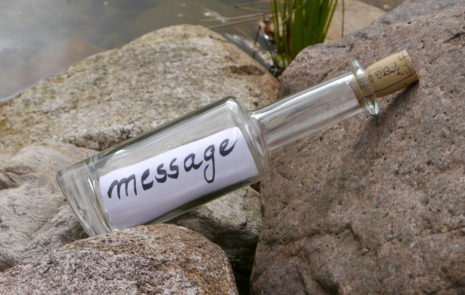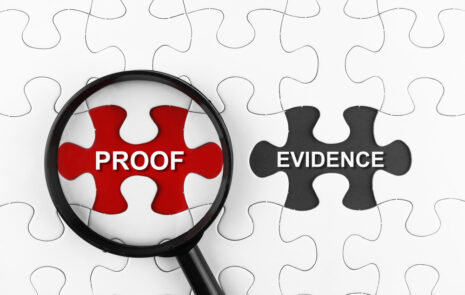
Reduce anxiety before your presentation
Do you experience anxiety before giving a presentation?
Giving a presentation is a great way to get your organization’s story heard. Yet many clients say two things often stop them from public speaking.
The first hurdle is time. The time it takes to create and practice a presentation. If you’re well-versed in your topic, and you create a one-page message map, then making your presentation should be quicker and easier.
The second hurdle I hear from clients is anxiety. I get it. It can be daunting to speak in front of a large group.
I had to deal with anxiety about speaking early in life. In seventh grade I was in a school play. I did well in rehearsals, but when opening day came, I was terribly nervous. I peeked out through the curtains and saw an auditorium filled with what I assumed were judgmental classmates.
Right before my cue to go onstage, my classmate Fred grabbed my eyeglasses off my head, said, “You’re not wearing these out there,” and pushed me onto the stage. I had zero time to react. But since I couldn’t see a single face in the audience, my anxiety evaporated.
To be clear, I don’t suggest that anyone use this tactic. A, it’s unsafe, and B, easing nervousness is not a one-size-fits-all situation.
But it taught me a crucial lesson. Even if you’re exceptionally prepared to speak in front of an audience, and it’s what you really want to do, you can still be nervous. One of the main keys to easing anxiety is finding the cause.
Identify the cause of your presentation anxiety
Any condition is difficult to cure until you find the root cause. While coaching hundreds of people on presentations, I’ve noticed two common causes of anxiety: lack of preparation and plain, simple nerves.
Once you know what is causing your anxiety, you can work on ways to fix or at least reduce it.
Make time to prepare your presentation
If lack of preparation is the cause of your anxiety, that’s easy to fix. It just takes a little time.
If you don’t take enough time to prepare, then should you really give the presentation? No!
Giving a presentation unprepared reduces your chance of getting your story heard. And it shows a lack of respect for your audience.
To ensure you have time to create your presentation, block time on your calendar well in advance of your deadline. Protect those blocks of time as you would any important meeting or event. I recommend a minimum of 4 one-hour blocks: a block to create your message map, a block to create your presentation, a block to revise your presentation, and a block to practice your presentation.
Make sure your blocks are neither too close together nor too far apart. You want time to reflect between blocks but not so much time that you lose your momentum.
Always practice your presentation
Regardless of how well you know your topic and your slides, if you don’t practice your presentation you are doing a disservice to yourself and your audience.

Practice enough so you know what you want to say during each slide or visual, if you are using any. Practice enough so you are comfortable speaking to and looking at your audience instead of looking at or reading your slides.
Avoid practicing so much that you sound like you are reading from a canned script. You should be able to gauge when you’ve rehearsed enough by your comfort level after your practice session.
Combat your anxiety before giving a presentation
If you’re well prepared for your presentation, yet you still suffer from anxiety, here are some things you can do to help lessen the effects.
Many of my clients find that simple breathing techniques are calming and help reduce nervousness and anxiety. You may need to try a few before you find the one that works for you, but the results can be worth it.
If the idea of receiving a tough question or one you can’t answer is the cause of your nervousness, remember that it’s okay to not know an answer on the spot.
On or off topic
When the question is on the topic of your presentation, simply state that you don’t have that information on the spot, and then offer to follow up with the person later.
If the question is off the topic of your presentation, remind the questioner that you are speaking on topic X and to respect the audience all questions should focus on that topic. When the off-topic question is something in your area of expertise and you would like to follow up with the person, offer to do so after your presentation.
When you are looking out a sea of faces activates your anxiety, I’ve found a few things that work. First of all, I no longer need to remove my glasses. I’ve found it’s much better to have 20/20 vision in everything I do.
In addition to ensuring I’m prepared, I remind myself that I’ve been asked to speak on my topic for a good reason, and that the audience is there to learn from me, not to critique me. I then find 2 to 4 friendly, encouraging faces as focal points to look at when making my key points. I’ve used this technique for years now, and it works brilliantly.

One other thing you can do is to take every opportunity you can to speak in front of other people. Present at internal meetings, give a toast or speech at an event, or even join Toastmasters if you have the time. Giving a presentation is like everything else in life: the more you do it, the easier it gets.
Be aware of your body language
Even experienced speakers and people who aren’t nervous sometimes give the appearance that they are. When you practice your presentation, be aware of your body language and any nervous tics.
For example, I encourage people to move thoughtfully when presenting, such is when you are making a key point and you want to make sure the audience takes notice. However, be careful not to pace or sway, as these motions can distract your audience and make you appear nervous.
Arrive early for your presentation to ease your anxiety before giving a presentation
To ensure you don’t run into any glitches or mishaps that can cause anxiety on the day of your presentation, always arrive early. This will give you the chance to see the room layout and test your visuals if you are using them. Always bring a backup copy of your visuals, a clicker you’re familiar with, an extra battery in case it’s needed, etc.
If you do experience a glitch, acknowledge it or fix it, and move on. Everyone in your audience understands that technology can fail at any moment.
It’s estimated that anywhere between 25% and 75% of Americans fear public speaking. If giving a presentation activates your nerves, preparation, practice, and breathing techniques can help.
If you are seeking help creating or preparing for a presentation, we can help.
For more tips on how to deliver on-message communications, subscribe to our blog.
How to ease your anxiety before giving a presentation.
Related Posts
Discover Your Content Marketing Sweet Spot
Ready? Aim! Reach people with the right content marketing. Start with the right message. A review of B2B websites shows that marketers are really...
Are you earning brand loyalty?
I had the luxury of spending last month in Nafplio, Greece, where I was embraced by the locals. Restaurateurs, shopkeepers, and even the gentleman...
Top 100 Content Marketing Question: How do you efficiently take one piece of content and quickly adapt it across internal/external channels?
The question boils down to: how to quickly adapt content? Marketers constantly face the need to quickly adapt content across communications channels, audiences and...
How to prove content drives sales?
How to prove content drives sales? A marketer at OMD Worldwide asked “How to tie specific content executions to sales and brand metrics?” It’s...





